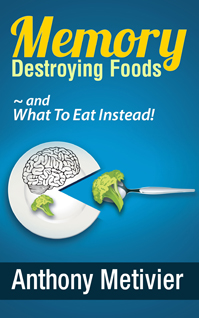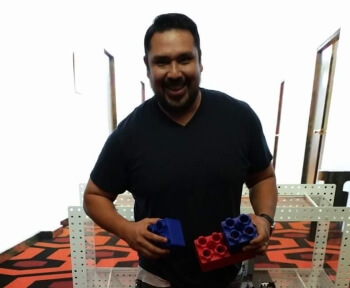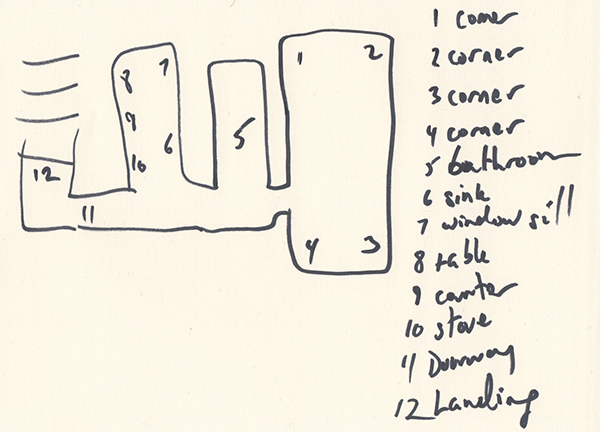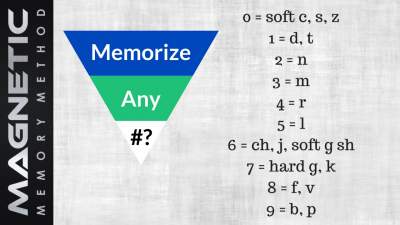Tue, 26 June 2018
And what if you had a simple autobiographical memory test you could give yourself again and again to keep improving your memory? If that sounds interesting to you, you’re in luck. Tap or click play now and discover:
And that’s just the beginning! The Profound Reasons Why You Have A Super Autobiographical MemoryIn this episode of the Magnetic Memory Method Podcast, I introduced a Memory Palace training exercise with Olivia. Olivia had a blank spot in her mind when I met her. So I took the opportunity to teach her a quick Memory Palace training exercise that anyone can do. It will let you experience recovered memory at a profound level that helps you learn languages. And when you unlock all of those Memory Palaces lying dormant in your autobiographical memory… Recovered Memory Can Become |
Wed, 20 June 2018
This is perhaps the best Magnetic Memory Method Review online so far: “The more you try it, the better you do. Every attempt is incrementally better than the last time.” -Jesse Villalobos Since constant improvement is what the memory method taught on this website is all about, I was delighted to hear these words from one of our course participants. Even better: Scroll up and click play. Listen in we talk about:
Of the many tips you’ll discover, here’s one of the most important points: Jesse keeps listening to the Magnetic Memory Method Podcast for motivation week after week. Yes, even though he completed the Magnetic Memory Method Masterclass. This point is important. Jesse’s approach combines a solid study ethic and continually feeding himself with ideas and inspiration. And when Jesse started, he was serious about getting results. He wanted to get really good at memorizing numbers. His success secret? Taking action! It’s not just about learning about memory techniques. It’s about applying them in meaningful ways one S.I.P. at a time: S.I.P. Study memory techniques Implement memory techniques Practice memory techniques with information that improves your life It’s this approach that helped Jesse get the mastery over the Person Action Object and Major Method that he wanted. Aside from remembering numbers, Jesse also learned how to remember names and faces. This skill provided other unexpected benefits from memory training that Jesse hadn’t even anticipated! If you’ve been looking for an extra bit of insight about how the Magnetic Memory Method can help you, try Jessie’s advice: Just dive into learning and using memory techniques. Download this episode and learn from Jesse’s experiences and insights. You’ll learn exactly how improving his memory has helped his personal confidence and well-being. Press play now and you’ll discover:
Do you have questions about how the Magnetic Memory Method can help you perform better at your work? Do you want more answers to your questions about mnemonics? If so, please dive into the episode and learn more about how you can get on a call with me. If you want me to help you transform into a walking, talking mnemonics dictionary, I’d like to help.
Further Memory Improvement Resources:
Get Good At Remembering Numbers How to Memorize Numbers With A PAO System [Person Action Object] Major System Secrets And The Future Of Your Memory With Florian Dellé
Want More Magnetic Memory Method |
Wed, 13 June 2018
Who doesn’t? After all, it’s the 21st century and there’s so much to learn! Seriously: There’s too much to study in too little time – especially before an exam. But it’s not just a time issue. It’s not just an issue of volume when it comes to so many books and videos to consume. The core of the problem isn’t any of those things. The core of the problem is memory… The things that your brain just can’t memorize no matter how many times you repeat them. Why? Because you don’t have a strategy for managing your learning and memory. But don’t worry! In this article, I will show you seven powerful techniques to help you remember anything you have to study. You’ll learn everything far more easily – facts, dates, formulae, equations, whatever. These techniques will make it far easier for you to ace your next exam. Let’s dive in. 1. The Memory Palace (The Top Recommendation)
Want just one simple method that helps improve memory for studying? Look no further than the Memory Palace. Memory champions and experts all agree that it’s the most effective method to remember anything at all. In fact, one expert used the technique to memorize the value of Pi till nearly 112,000 digits. This memory technique was developed in Ancient Greece. It is sometimes referred to as the ‘Method of Loci’ or ‘Cicero Method.’ You might also hear it called the ‘Roman Room’ or the ‘Journey Method’. Although there are many variations, here’s the core of how it all works. With the Memory Palace technique, you associate each piece of information you want to memorize with parts of a location that you are very familiar with – such as your house or your school campus.
Why “Method of Loci” Memory Technique Is Too Vague…
In the Magnetic Memory Method, we don’t use the term “loci.” It’s too vague. Instead, we work with Magnetic Stations. On these stations we place our Magnetic Imagery. For instance, if you wanted to remember a number of important dates about the Second World War, you could ‘file them’ in your medicine cabinet. Or, better said, “Magnetize” them in place. Associating each bit of information with a physical object within a familiar space helps the brain store the information. More than just store it, your brain stores the study material systematically and retrieves it easily when needed. Just make sure to draw your Memory Palace first for the best results. Like this:
Seriously go ahead and draw your Memory Palaces. Once you know the strategy behind why Magnetic Memory Palaces serve better than the rest, each one should take 2-5 minutes (or less). The best part? You can use this memory retention technique to remember complex terminology, numbers, formulae – anything at all. If you are not a ‘visual’ person, you can still use the technique. You can also associate pieces of information with sounds, smells, touch – various sensory elements within the location. You do this by using the full range of the Magnetic Modes taught right here in this special infographic:
Probably the biggest strength of the Memory Palace technique is that you can combine it with other mnemonic methods to improve your long-term memory. I will show you a few examples of how to do this in the following sections. To learn about the Memory Palace and what the Magnetic Memory Method brings to the game in more detail, check out this article. 2. Acronyms to Improve Memory for Studying
Acronyms are the most commonly used memory technique and are great for remembering short lists or sequences. You have probably learned ‘PEMDAS’ in school – a sequence for solving equations. It stands for Parenthesis, Exponents, Multiplication, Division, Addition and Subtraction. Another common acronym to help you remember a geographical list of names is HOMES, which is used to remember the Great Lakes – Huron, Ontario, Michigan, Erie, and Superior. Here’s a simple tip to create your own acronyms for remembering things better. According to the Cambridge dictionary, acronyms are constructed with the first letter of each constituent word and they actually sound like words. That’s what makes them easy to remember. We also use acronyms in the Magnetic Memory Method training, such us: Doing is the Origin of Consistency Doing is the Origin of Creativity Doing is the Origin of Courage Doing is the Origin of Clarity Doing is the Origin of Control To get into the “doing” of memory techniques that ultimately leads to control over your memory, all you have to do is S.I.P.: Study memory techniques Implement memory techniques Practice memory techniques with information that improves your life And as you saw in the infographic above, COG KAV helps us remember all the Magnetic Modes:
And let’s not forget the Magnetic Mode of space. That’s the Memory Palace itself. But moving from these examples of acronyms, let’s get back to the technique of using them. You might be wondering… What do you do if the first letters don’t form a ‘word,’ because of a lack of vowels in the middle or any other reason? Forget the definition and get creative. Try changing the word sequence or using the second or the last letter instead of the first. If there is no vowel, pick up a second letter from a word. A common example is AWOL (Absent Without Leave.) If you like acronyms, try combining them with the Memory Palace technique. Since each acronym is a word, it’s easy to associate them with a specific object or location in your house. That will make it even easier to remember. 3. Spaced Repetition for Memory Improvement
Here’s a well-known fact about memory – the more you reinforce something, the easier it becomes for your brain to recall it. However, to improve memory for studying, when you reinforce something is far more important than how often you reinforce it. Sisti, Glass and Shors called this phenomenon the ‘spacing effect.’ In the spaced repetition method, you practice remembering at the right time. The simplest way to apply this memory method is to use flashcards when you study. While going through your flashcards, divide them into three bundles. If you remember something clearly, those cards go into the ‘Easy’ pile. You don’t have to study those flashcards again for a week or two. If you moderately remember something, keep it in the ‘Medium’ pile and revisit it after a few hours or a day. And if you cannot remember something at all, place it in ‘Hard’ and study it again within the next 10 minutes. Simple, and yet effective! At least… lot more effective than spaced-repetition software. And if you’re in the Magnetic Memory Method Masterclass, you’ll know how to combine the cards with the Memory Palace. In brief: Anytime you have words that are ‘Medium’ or ‘Hard’, include them in a Memory Palace. Then, use all of the Magnetic Modes to create Magnetic Imagery that helps you remember the target information. That will make the information on your cards far easier to recall. 4. The Major Method for Memory Improvement
Want an effortless way to remember numbers for studying – in history, maths, physics, etc.? Use the Major Method, also called the Major System or Harry Lorayne’s Number Mnemonics. Geeks also call it the phonetic mnemonic system and digit-consonant system. Quite a mouthful! So, let’s just stick with the ‘ Major Method’! Here’s how it works. In the Major Method, you associate each number with a sound, typically, a consonant. Here’s the system most people follow: 0 = soft c, s or z 1 = d, t
2 = n 3 = m 4 = r 5 = l 6 = ch, j or sh 7 = k 8 = f or v 9 = b or p
The first step is to memorize these associations between numbers and letters. Then use these associations to form words from numbers. For instance, 22 could be “nun” (n+n)
54 could be “liar” (l+r). Personally, I think of Jim Carrey in the movie “Liar Liar” with a lyre to help make it even more memorable. To remember longer sequences of numbers, you need to combine the sounds you have made. If you want to remember the number 2254, you could visualize a nun punching Jim Carrey for lying! Make the image as animated and ridiculous as possible, and it will stick in your mind! If you can, create a fixed image for every number from 0 to 99. That will make it easier to combine them to remember longer sequences of numbers used in mathematics, physics, chemistry or engineering. If that sounds like a lot to you, just associate a fixed object for each number from 0-9. If you want to take the Major Method further, check out this article about how to combine it with the Memory Palace Technique. 5. Improve Your Focus to Improve your Memory
How often do you get interrupted when you study? Texts, app notifications, YouTube, Netflix or just a noisy room – students face dozens of distractions and interruptions every single hour. These factors make it close to impossible for you to reach a high level of concentration – which is terrible news if you are trying to improve memory for studying. Researchers from MIT have found that it’s easier to form a long-term memory when your mind pays close attention to a task. You will have to minimize distractions from devices or people around you if you wish to remember things better. Here are a few ways:
6. Lifestyle Changes to Improve Memory for Studying
Your lifestyle – your food, sleep and activity levels have a significant impact on your memory. Sleep Most students try to gain more time to study by skipping out on adequate sleep. It just makes things worse because lack of sleep affects memory as well as several other cognitive abilities. Several studies by Diekelmann and Born have shown that sleep helps in procedural memory formation, learning and creativity. In fact, sleep deprivation can even make you remember things incorrectly. Eight hours is ideal, but at least make sure you get seven hours of sleep every night. And don’t fall for the idea that binaural beats will help you improve your memory while sleeping. Chances are that will just make you tired and forgetful.  Video course and Ebook in the Magnetic Memory Method Masterclass Food Foods abundant in saturated fats and trans fats such as red meat, butter, etc. are quite damaging to learning and memory. Students also tend to eat a lot of junk food (especially during exam time) which are worse for your brain. Numerous studies have shown that these foods can even lead to Alzheimer’s disease in the long-term and other conditions that damage brain health and cause memory loss. Instead, to improve your memory power for learning, try to have more of fish, olive oil, whole grains, walnuts, blueberries. There are also other foods that fall in the ‘Mediterranean diet’ that are excellent for your brain. Exercise Exercise is well known to improve cognitive performance in several ways such as improved mood, better concentration, more alertness, etc. So, it’s naturally very effective for improving memory. Exercise also causes the release of a protein called cathepsin B in the brain. This stimulates the growth of neurons (brain cells) and forms additional connections in the hippocampus – an area of the brain vital to learning and long-term memory. 7. Recall Before Writing
Teachers encourage us to write things down to remember things better. Adding a couple of steps to this process can make a vast difference to your ability to learn and memorize things quickly – especially before an exam. First, recall and mentally repeat what you have to write down rather than just copy it mechanically. You can even use movies and TV series as I discuss in how to improve memory using these tools This process isn’t difficult to do because the information will stay in your short-term memory for around 10-20 seconds if you have paid attention. And mentally recalling it right then it an excellent way of transferring it from your working memory (short-term memory) to your long-term memory. Next, take a few seconds to store that piece of information in your Memory Palace. That will consolidate that memory even further.
Are You Inspired To Try These Memory Techniques?
Out of all these techniques, the Memory Palace happens to be the most effective and versatile method. You can easily combine it with other techniques to build an excellent memory. To learn the Magnetic Memory Method at no charge, get started by enrolling for my Memory Palace Mastery in 8 Steps Course: And let me know in the comments below: Which of these ways to improve memory for studying are you going to try today? The post How to Improve Memory for Studying (7 Powerful Tips) appeared first on Magnetic Memory Method - How to Memorize With A Memory Palace.
Direct download: How_to_Improve_Memory_for_Studying_7_Powerful_Tips.mp3
Category:Podcast -- posted at: 11:46pm EDT |
Thu, 7 June 2018
They think binaural beats can help you follow a diet or stop smoking. Or they think these sounds can amp you up for a competition or calm you down, or even improve memory recall, focus and concentration. The question is… Doesn’t listening to any type of relaxing music have a similar effect? Possibly. In this post, we’ll find out if listening to specific frequencies can have a better impact on your mental prowess than listening to Mozart for Pink Floyd! What Are Binaural Beats?
The word binaural means “having or relating to two ears.” The process works by sending a slightly different sound frequency to each ear. This has to be done simultaneously and through earphones or headphones. When two different pure tones are presented separately but simultaneously to each ear of a listener, the listener hears the illusion of a third tone. This third does “appears” in addition to the two pure-tones presented to each ear. And it is this third tone that is called a binaural beat. Let’s break this down: The brain then uses a process known as ‘frequency following response’ to follow along at the new frequency (10 Hz). This process produces brainwaves at that rate of Hertz. However, this outcome (apparently) occurs only if the the difference matches the alpha frequency range that lies between 7-11 Hz. Music or white noise embedded with binaural beats is very often used along with different meditation techniques and positive affirmations to gain varying results. In the memory training and memory improvement world, some claim you will experience results ranging from improvement in recall, concentration, focus, creativity and alertness. There is more: Listening to these beats is also said to provide relaxation, stress reduction, pain management, and improved sleep quality.
Who Heard Them First? |
The Magnetic Memory Method Podcast

Categories
generalMemory Improvement Tools
Memory Method Tips
Brain Exercises for Memory Improvement
Memory Improvement Case Studies
Podcast
Guest Post
Memory Palace Tactics
Practical Memory Techniques
Uncategorized
Improve Memory Q&A
Archives
AprilMarch
February
January
December
November
October
September
August
July
June
May
April
March
February
January
December
November
October
September
August
July
June
May
April
March
February
January
December
November
October
September
August
July
June
May
April
March
February
January
December
November
October
September
August
July
June
May
April
March
February
January
December
November
October
September
August
June
May
April
March
February
January
December
November
October
September
August
July
June
May
April
March
February
January
December
November
October
September
August
July
June
May
April
March
February
January
December
November
October
September
August
July
June
May
April
March
February
January
December
November
October
September
August
July
June
May
April
March
February
January
December
November
October
September
August
July
June
May
April
March
February
January
December
November
September
| S | M | T | W | T | F | S |
|---|---|---|---|---|---|---|
| 1 | 2 | |||||
| 3 | 4 | 5 | 6 | 7 | 8 | 9 |
| 10 | 11 | 12 | 13 | 14 | 15 | 16 |
| 17 | 18 | 19 | 20 | 21 | 22 | 23 |
| 24 | 25 | 26 | 27 | 28 | 29 | 30 |
Syndication

 What if I told you that recovered memory is a skill that you can use to create a better Memory Palace Network?
What if I told you that recovered memory is a skill that you can use to create a better Memory Palace Network?

 Do you want to know how to improve your memory for studying?
Do you want to know how to improve your memory for studying?





 It’s a popular perception among many people that listening to binaural beats has a special effect on the brain.
It’s a popular perception among many people that listening to binaural beats has a special effect on the brain.